In a nation where menstruation is often surrounded by stigma and taboo, the Kamakhya Temple in Assam stands as a beacon of progressive and inclusive beliefs.
Here, menstruation is not shunned or considered impure but revered as a sacred blessing of the Goddess.
Every year during the monsoon season, the serene Nilachal hills in Guwahati transform into a vibrant pilgrimage site for the Ambubachi Mela.
This four-day festival celebrates the annual menstruation of the Goddess Kamakhya, drawing thousands of devotees, sadhus, sanyasis, and tantrics from India, Nepal, Bangladesh, and beyond.
The atmosphere during the festival is electric, with devotees engaging in nostalgic music, mystic chants, and spiritual fervour, all united by their devotion to the Divine Mother.
The Ambubachi Mela is considered the most potent and sacred time for the Goddess.
The festival begins with the temple gates being closed for the first three days to symbolise the Goddess’s menstruation.
During this time, the Yoni or the stone shrine within the temple is bathed daily and offered a red silk cloth to signify the menstrual flow.
This red cloth holds immense significance for the devotees, who often take pieces of it home as a blessed token.
On the fourth day, the temple gates are flung open, and thousands of devotees, who have waited patiently, rush in to get a glimpse of the Goddess.
This event marks the end of the Goddess’s menstruation and the reopening of other temples in the region.
The Kamakhya Temple’s celebration of menstruation as a sacred and powerful event is a stark contrast to the often-negative perceptions surrounding menstruation in many parts of India.
It serves as a reminder of the deep-rooted cultural respect for the feminine divine and the natural cycles of life, offering a hopeful sign for overcoming menstrual taboos and promoting a more inclusive and respectful understanding of womanhood.
The Kamakhya Temple, through the Ambubachi Mela, not only honours the divine feminine but also challenges and redefines societal norms, encouraging a broader acceptance and reverence for natural bodily processes.
This annual festival is a powerful testament to the potential for cultural transformation and the celebration of the sacred feminine in all its forms.















